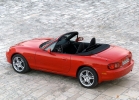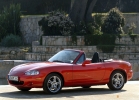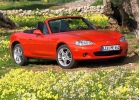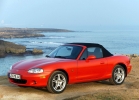Test drive Mazda MX-5 (MIATA) 1998-2005 convertible
Yellow monster
 In the spring of 1989, at a car dealership in Chicago, a small double open MX-5-5-5-5-5 car, exhibited by Mazda Corporation, produced a splash. Ten years later, in February 1999, Mazda noted this event - twice. Firstly, having released the anniversary edition - 1999 Mazda Miata 10th Anniversary Edition. Secondly, having manufactured a five hundredth car of this model. James Miller himself downloaded the car from the conveyor of the plant in Hiroshima, President Mazda Motor Corp.
In the spring of 1989, at a car dealership in Chicago, a small double open MX-5-5-5-5-5 car, exhibited by Mazda Corporation, produced a splash. Ten years later, in February 1999, Mazda noted this event - twice. Firstly, having released the anniversary edition - 1999 Mazda Miata 10th Anniversary Edition. Secondly, having manufactured a five hundredth car of this model. James Miller himself downloaded the car from the conveyor of the plant in Hiroshima, President Mazda Motor Corp. Half a million cars! Undoubtedly, the Mazda MX -5 is the most popular classroom in the world of the last decade. It is sold in 50 countries, about half of the cars are spent in the USA - called MIATA (the MX -5 index is used in Europe, and in Japan the car is known as Eunos). Ten years ago, the car took the baton at the old MGB and today is almost an icon for admirers of light double sports cars.
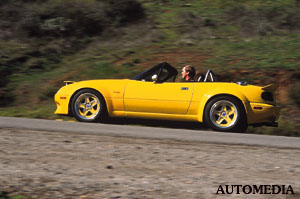 The main advantages of Miata are a stylish classic body, low price and excellent running qualities. The main drawback is a relatively weak 4 -cylinder motor (only 140 hp), nothing else is proposed. The anniversary publication is not a solution to the issue. Differences from the serial, 99 miata he has mainly cosmetic. Well, they replaced the excellent box so, added stretching between the front racks, set the suspension a little differently ... The engine remained the same.
The main advantages of Miata are a stylish classic body, low price and excellent running qualities. The main drawback is a relatively weak 4 -cylinder motor (only 140 hp), nothing else is proposed. The anniversary publication is not a solution to the issue. Differences from the serial, 99 miata he has mainly cosmetic. Well, they replaced the excellent box so, added stretching between the front racks, set the suspension a little differently ... The engine remained the same. But there is a way out - for those who do not mind add $ 35,000 to the cost of the car. The Italian company La Forza Motors, which specializes in the individual manufacture of SUVs with large Ford engines, has a department in California - Monster Motorsports, which makes the same with Miata cars. In four weeks (and the amount indicated above) your modest rubber will be turned into a fire -breathing monster, which will leave far behind 99% of sports vehicles that were nearby at a traffic light. Over the past six years, Monster Motorsports has remade 250 cars.
I managed to spend the day with John Smith, the main engineer of the company. While we were rushing with him on a canary-yellow car along winding roads near the town of Escondito, John told me something about how they reconstructed Mazda Miata. I saw something else with my own eyes.
There are three options for alteration. The first provides for the installation of 5 liters of the Ford V8 engine - the base Monster miata is obtained. The second option is that the same motor is supplied with a mechanical supercharger, while the Roger receives the name Mega -Monster. The third is equipped with a supercharger of the Miata Motor, but rarely resort to this option (the buzz is not the same).
At first, the car is almost completely disassembled. The frame is amplified, more powerful engine and transmission supports are installed. The motor compartment is cleaned of everything superfluous, even the battery is transferred to the trunk - you need to free up space for a new power unit.
 Motors usually take from the Ford Mustang of the early 90s (at that time the company used forged, not alloy pistons). The engine is installed on the base Monster without any alterations. At the exit - standard 225 hp
Motors usually take from the Ford Mustang of the early 90s (at that time the company used forged, not alloy pistons). The engine is installed on the base Monster without any alterations. At the exit - standard 225 hp The same motor, equipped with a Kenne Bell Twin-Drive (Whipple) compact supercharger, and with more productivity injectors, it already gives 400 hp. Specific power - 2.9 kg/hp. (for comparison: in the original miata - 7.3 kg/hp).
What about other supercars?
Lamborghini Diablo SV - 2.9; Ferrari 550 Maranello - 3.5; Aston Martin DB7 Vantage - 3.4 ... Indeed, Mega -Monster!
An excellent 6 -speed box Miata is ruthlessly thrown away (not in the trash, of course) - it will not digest the torque of the new motor. Instead, a 6-speed Ford T5 mechanics is installed, most often from Mustang GT, the rear bridge also has to be changed from Mustang GT after 1988. At first they put bridges from Mazda RX-7, but they were weak. Now - from Thunderbird, with a differential of high friction.
The suspension modifications are associated with the installation of 12 mm springs and more rigid reptile stability stabilizers (22.2 mm in front and 15.9 mm behind) with nylon supports. Brake mechanisms - from Mazda MX -7, with dried disks.
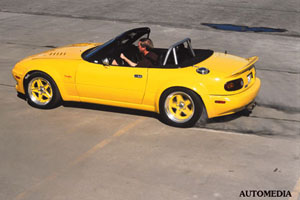 The rest of the alterations are forced and seem trifles compared to the listed. Naturally, the new radiator of the cooling system of a more powerful engine is with two fans. Of course, the new exhaust system is Flowmaster with two exhaust pipes. For the second pipe, you need to cut a bumper. But what a sound! And, of course, - at the cost of losing a number of horses - you have to put two catalytic neutralizers, otherwise the car will not be released on the road in California.
The rest of the alterations are forced and seem trifles compared to the listed. Naturally, the new radiator of the cooling system of a more powerful engine is with two fans. Of course, the new exhaust system is Flowmaster with two exhaust pipes. For the second pipe, you need to cut a bumper. But what a sound! And, of course, - at the cost of losing a number of horses - you have to put two catalytic neutralizers, otherwise the car will not be released on the road in California. The wheels are 16 -inch, rubber Pirelli P700, in front - 225/40ZR16, behind - 245/45ZR16. The steering is native, but it is deprived of an amplifier - it simply does not fit under the hood.
Miata modifications are also provided - not radical, but corresponding to the new filling of the machine. The hitch kit includes a bow of fiberglass with enlarged air intakes in the bumper, a new aluminum hood, wheel arches, rear anti -wing, a safety arc and a number of smaller parts. The converted car is somewhat reminiscent of the old Cobra. Something is changed in the cabin, the main thing is the seats ...
So what happens in the end? Mustang in the guise of Miata? The wolf is by no means sheep's skin? How will it ride?
 John allowed me to sit a little behind the wheel. How Mega Monster starts! On the idle, a calm, confident roar of the motor is heard, but you just need to press the gas ... a deafening roar - the tail of the car instantly turns out to be somewhere on the side, and then in front.
John allowed me to sit a little behind the wheel. How Mega Monster starts! On the idle, a calm, confident roar of the motor is heard, but you just need to press the gas ... a deafening roar - the tail of the car instantly turns out to be somewhere on the side, and then in front. Nothing to do with a meek, but the usual miata. The wheels can be twisted with smoke on the asphalt both in the second and third gear. To say that the rotation is redundant is to say nothing. The absence of a steering amplifier of catching rear wheels also does not facilitate - making it physically difficult. And it is extremely important to catch them quickly - the car is short, and due to excess power, it begins to wag the backwards almost without warning. To go to Mega Monster to the street, serious preparation, and a habit of a car, and a certain share of courage are required.
At least one third of these requirements I did not satisfy, and with a sense of relief I gave the steering wheel to John. In his hands, the car was surprisingly obedient. Of course, we did not measure any measurements, but John assures that acceleration to a hundred takes no more than 4 seconds, and a quarter mile from the place the car passes in 12.2 seconds. Maximum speed? Says 280 km/hour. In any case, the speedometer arrow very quickly rests against the limiter at the maximum mark - 140 miles/hour (226 km/h). And the braking distance at a speed of 100 km/h is less than 40 meters.
 There are, of course, disadvantages. Shock absorbers could be selected more captive - on the comb the car jumps slightly, but at the same time it is excellent in corners at incredibly high speed, withstanding side accelerations of 0.98 G.
There are, of course, disadvantages. Shock absorbers could be selected more captive - on the comb the car jumps slightly, but at the same time it is excellent in corners at incredibly high speed, withstanding side accelerations of 0.98 G. Even by the standards of the beginning of the 90s, the motor cannot be called economical, and even in the current ... In traffic jams, the engine overheats very quickly (its cooling is slowly prevented by the additional air conditioner radiator). But if you want to be paid attention to you, then you can easily make any Mustang, Corvette, Camaro or Porsche from a traffic light. I agree that $ 35,000 is a lot, but if you add to this amount the cost of the base miata, it will turn out less than the same ZR1 Corvette or Dodge Viper costs. You will be in California, look at John and his guys.
Text: Andrea Conrad
Photo: Automedia.
 The path of rain drops
The path of rain drops Tom Matano, one of the creators of the Mazda RX-5 and RX-7, once thought why the cars of some companies (for example, Pininfarina) are presented in branded pictures in a natural environment, and other (in particular, many Japanese ones) are removed in the studios. Leafing through the press releases and sorting out the photographs, Tom came to the conclusion - if the car harmonizes with the surrounding nature and at the same time stands out in the picture, then its designers worked perfectly.
Nature, machine, design ... How to adapt these not very clear concepts for practical work?
Tom since childhood loved to wash and polish cars. Rubing the wax applied to the body, he studied the transitions of surfaces, watched the game of light, listened to the sensations that were transmitted from metal to hand.
His first car - Datsun Bluebird, the design of which was developed by the Pininfarina studio - Tom recalls so far: it was very easy and natural to polish it. I especially liked to rub the smooth bends of the bumper ...
Experimenting with friends of friends, entering car dealerships, Tom drove his hands to different parts of the body, trying to imagine how nice it would be to rub wax on them, and whether the sensations of what he feels coincides with what he sees.
Tom began to watch the drops of water rolling from the body - on the sink, under the way we wait, on the go. The theory of the rain drop was gradually born.
I imagine myself a drop of rain that has fallen on the roof of the car. I roll to the windbreaker or rear glass, quickly go down the counter to the front or rear bumper. My path is determined exclusively by the shape of the body surfaces. And if I - like a rain drop - at least for a second will have to think about where to move on, it means that something is not in design ...
We took into account all these sensations when we created Miata. You go on this machine - and you see with what ease and naturalness drops of rain from its surfaces scalp. When you rub it with wax or wash it with shampoo, with your palms you feel soft crossings on the hood, along the doors, on bumers ... Have you tried to wash MR2?
A source: Motor magazine [No. 4/1999]
Video crash tests Mazda MX-5 (MIATA) 1998-2005
Test drives Mazda MX-5 (MIATA) 1998-2005
Mazda MX-5 (MIATA) 1998-2005 Krash Test
Krassh Test: Detailed Information25%
Driver and passengers
7%
Pedestrians

